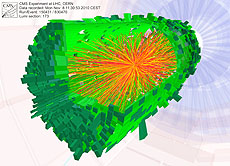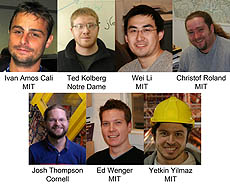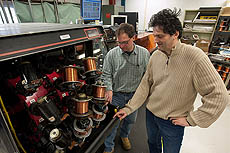Subatomic mythbusters: Confirmed
 |
| One of the first lead-ion collisions in the LHC as recorded by the CMS experiment on November 8, 2010. Image: Courtesy of CERN |
In 2006, the popular television show Mythbusters tried to test a legend, which was that two Civil War-era bullets, if fired at one another, would fuse into a single bullet. The team was unable to confirm the myth, simply because it was too hard to get the bullets to collide. They eventually did a simpler test and fired one bullet into a stationary bullet and found that the two bullets did indeed fuse. They listed the legend as plausible. And in 2009, a story in the UK's Daily Mail showed two bullets fired during the Crimean War that were reported to have hit in midair and fused. The odds of this occurring were incredibly small, but even rare things happen.
At the LHC, bullets made of lead don’t collide in the accelerator, but lead nuclei did during the December 2010 running period. Every second, two clouds of 100 trillion of these subatomic lead bullets passed by one another and something like 200 times per second two of them collided head on. The fireball formed between colliding lead nuclei is much more complex than ordinary collisions between protons, which makes it correspondingly more difficult to study the details of these collisions.
For some physicists, lead nuclei collisions weren’t enough. They wanted to see something never before observed. They wanted to be the first to see Z bosons in collisions between heavy nuclei. Z bosons can decay in many ways, but a decay into pairs of muons is the most striking signature.
A short while ago, CMS reported an observation of lead collisions that produced Z bosons. Because muons can escape the fireball more-or-less unscathed, this observation opens a unique window into the collision’s inner workings. In the paper described today, CMS physicists report the results of a detailed study of 39 Z bosons made in collisions between lead nuclei. We are just beginning to exploit the capabilities of the LHC.
And, with all due respect to the producers of Mythbusters, the accelerator scientists at the LHC have tested the idea of colliding subatomic lead bullets. Verdict: confirmed.
-- Don Lincoln
 |
|
These scientists, in collaboration with their foreign colleagues, are responsible for this discovery.
|
 |
|
Any measurement of this magnitude is not possible without considerable effort to make sure the right events are recorded and then reconstructed properly. Equally important is the ability to correctly simulate the data. These scientists are just a few who contributed to the "nuts and bolts" that made this analysis possible.
|
| 


